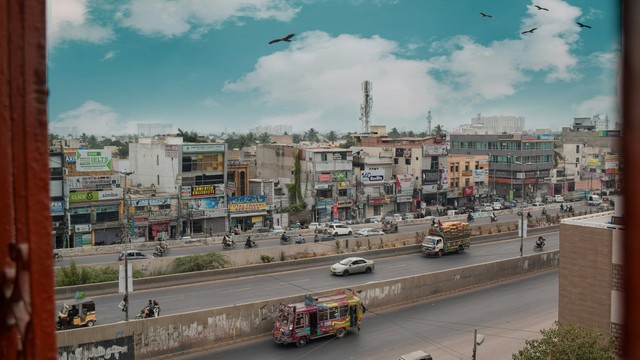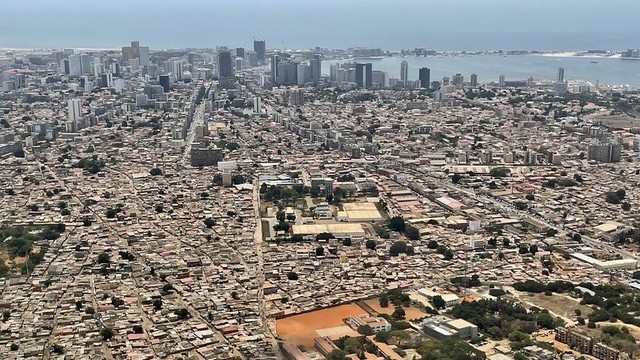Asia’s fastest growing cities… and why these are mostly small cities
When urban specialist David Satterthwaite was handed a list of Asia’s fastest growing cities he didn’t recognise any of them, while the list of those with the largest annual increases in population was very familiar. Why was that?


Yichun, in Jiangxi province, China, is among Asia's fastest growing cities (Photo: Gary Todd, via Flickr, CC0 1.0)
This blog looks behind the lists featured in the tables below and seeks reasons for the unexpected dominance of China – which has five of Asia’s most rapidly growing cities 2000-2020, including three in the top ten.
Cities have always been associated with centres of political power. Most of the world’s 100 largest cities in 2020 were either national capitals, or state or provincial capitals for the next tier of government, and have been important centres for centuries. But most of the fastest-growing cities today owe their rapid growth to economic success. Few of them have had historical importance.
Previous blogs on the world’s fastest-growing cities (2020) and on Africa’s fastest- growing cities (2022) generated such a large readership that we decided to cover other regions of the world too. So here is Asia, and its cities with populations growing by hundreds of thousands each year (table 2). It’s hard to imagine how city governments can cope. Indeed most of these cities have huge backlogs in housing and basic services that demand attention.
Then there are the cities with populations that grew very rapidly – including some that grew more than fivefold in two decades (table 1). And why is there no city in both these rankings (although Malappuram comes close)? What we measure turns out to be the key.
Measuring city populations
A city’s population growth is usually measured by its annual average population growth rate (table 1). But city and national governments need to know the absolute change in population each year, as this is the number of newcomers (by birth or in-migration) needing housing and public services.
So in this case, it is the annual average increment in population that is of interest (table 2).
Ranking by population growth rates
In table 1 we can clearly see the dominance of China and India. China has five of the 20 fastest growing cities while India has four.
Table 1: Asia’s most rapidly growing cities 2000-2020
| Country or area | Urban agglomeration | Popn 2000 (thousands) | Popn 2020 (thousands) | Growth rate 2000-2020 (%) |
| Qatar | Doha Industrial Area | 37 | 419 | 12.8 |
| China | Xiongan | 125 | 970 | 10.8 |
| Bangladesh | Rupganj | 76 | 482 | 9.7 |
| China | Miluo | 109 | 604 | 8.9 |
| India | Hosur | 94 | 494 | 8.6 |
| Iran (Islamic Republic of) | Shahriyar | 71 | 364 | 8.5 |
| Myanmar | Nay Pyi Taw | 117 | 594 | 8.4 |
| China | Bazhong | 212 | 992 | 8.0 |
| Thailand | Phuket | 94 | 432 | 7.9 |
| Bahrain | Al-Manamah (Manama) | 142 | 635 | 7.8 |
| India | Malappuram | 762 | 3,391 | 7.8 |
| India | Begusarai | 106 | 468 | 7.7 |
| China | Liuyang | 272 | 1,169 | 7.6 |
| Yemen | Ibb | 154 | 649 | 7.4 |
| Viet Nam | Thu Dau Mot | 100 | 413 | 7.4 |
| China | Yichun, Jiangxi | 222 | 918 | 7.4 |
| Jordan | Tila al-Ali | 80 | 327 | 7.3 |
| India | Kottayam | 172 | 696 | 7.2 |
| Jordan | Al-Quwaysimah | 101 | 385 | 6.9 |
| Yemen | Al-Mukalla | 136 | 506 | 6.8 |
Ranking by annual average increments in population
But if we measure annual average increments in city populations, a completely different list of cities emerges – see table 2. This is a much more familiar set of cities but the scale of their population increment is astonishing. Some cities add hundreds of thousands of people to their populations each year.
By this measure, China has ten of the 20 top cities. This is all the more incredible when rates of natural increase there are very low, so the increments were clearly driven by in-migration.
India has six in the top 20, while Pakistan has two. So only two of the top 20 cities were outside China, India or Pakistan – Istanbul (Turkey) and Dhaka (Bangladesh).
Some caution is needed, however, when comparing increments in population between cities, because boundary extensions, or changing city/metropolitan government systems (which produce different boundaries) often include large populations that were not previously considered part of a city or urban area.
Table 2: Asian cities with the largest annual average increment in their population, 2000-2020
| Country or area | Urban agglomeration | Popn 2000 (thousands) | Popn 2020 (thousands) | Average annual increment 2000-2020 (thousands) |
| India | Delhi | 15,692 | 30,291 | 730 |
| China | Shanghai | 14,247 | 27,058 | 641 |
| Bangladesh | Dhaka | 10,285 | 21,006 | 641 |
| China | Beijing | 10,285 | 20,463 | 509 |
| China | Chongqing | 7,863 | 15,872 | 400 |
| Pakistan | Lahore | 5,576 | 12,642 | 353 |
| India | Bangalore | 5,581 | 12,327 | 337 |
| China | Tianjin | 6,989 | 13,589 | 330 |
| Turkey | Istanbul | 8,744 | 15,190 | 322 |
| Pakistan | Karachi | 9,825 | 16,094 | 313 |
| China | Shenzhen | 6,550 | 12,357 | 290 |
| China | Guangzhou, Guangdong | 7,812 | 13,302 | 274 |
| China | Suzhou, Jiangsu | 2,112 | 7,070 | 248 |
| China | Nanjing, Jiangsu | 4,279 | 8,847 | 228 |
| China | Chengdu | 4,607 | 9,136 | 226 |
| India | Surat | 2,706 | 7,185 | 224 |
| India | Chennai (Madras) | 6,593 | 10,971 | 219 |
| India | Hyderabad | 5,650 | 10,004 | 218 |
| India | Mumbai (Bombay) | 16,147 | 20,411 | 213 |
| China | Xi'an, Shaanxi | 3,788 | 8,001 | 211 |
Underpinnings of rapid growth
The fact that five Chinese cities are among the 20 Asian cities with the fastest population growth rates (and that China has 49 of the 100 fastest growing cities in Asia) reflects China’s very rapid economic growth over decades. Other contributory factors are its generally pro-urban government policy and support for special economic zones.
As is the case in Africa and globally, it’s striking how few of Asia’s fastest growing cities are among its largest (see table 1). The world’s largest cities never appear in lists of the world’s most rapidly growing cities if population growth rates are used to compile this list – although they inevitably did so when they were smaller.
The largest cities must have been among the fastest-growing cities in the past, otherwise they would not be among the largest cities today.
From small beginnings
Most of the cities with the fastest population growth rates from 2000 to 2020 were small cities at the start of the century – with five of the top ten having under 100,000 inhabitants back then.
So what you have in many Asian nations is a number of small cities growing very fast. For large population nations, if this is sustained, they will join the ‘largest city’ rankings. To state the obvious, large cities can only develop in countries with large populations.
The data also reveals the following:
- Among the fastest growing cities, the Doha Industrial Area is a district of Doha Municipality (Qatar) which also includes the national capital
- Xiongan is one among an astonishing number of ‘new areas’ in China, most of which are growing very fast after benefitting from special economic and development support from central or regional government. Many of these are within or close to much larger cities. Those that are independent cities are likely to feature prominently in Asia’s fastest growing cities rankings for 2020-2030
- Among the other 18 cities, two are national capitals, Nay Pyi Taw (Myanmar) and Al-Manamah (Bahrain), while most of the others are provincial capitals, and
- Five are very close to or within very large cities: Miluo and Changsha (China); Hosur and Bengalaru (India); Thu Dau Mot and Ho Chi Minh (Viet Nam); Tila al-Ali and Al-Quwaysimah and Amman (Jordan).
But in each of these cities we need to understand the varied, complex and ever-changing specific local contexts and subtleties, and the key private and public external influences. How different China’s urban landscape would be if the country had remained Maoist and anti-urban.
For some, growth may be shortlived
When reviewing inter-census changes in population for all urban centres in a country, there are often small cities with very rapid population growth rates for one or two census periods – more rapid even than the cities in table 1.
For instance many small cities have doubled their population in ten years as they take on new government functions, become favoured economic zones or develop as tourist centres. But most do not sustain this very rapid growth.
Pointers for future growth?
There is a great enthusiasm for lists of cities and their populations’ rate of change. But ‘league tables’ of cities need to be drilled down to work out what is really going on – and what all this could mean for the future of Asian cities more generally.
And how will this list change from 2020-2040?
It will no doubt reflect: changes in the global economy; the resolution (or not) of conflicts impacting Asian cities – for instance in Syria, Yemen and Myanmar; the growth of artificial intelligence and how it is used; and of course the vast global and local influences of the climate crisis and how this is shaped by the quality of city and national responses for adaptation and mitigation.
As in the previous blogs linked above, we recognise its limitations (including the fact that it has not been updated). For many nations, there is no recent census so city populations are estimates or projections. These can be mean large overestimations for cities in crisis – for instance Ibb and Al-Mukalla in Yemen in table 1.



